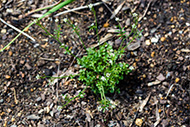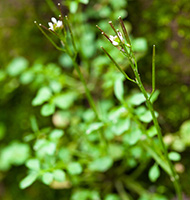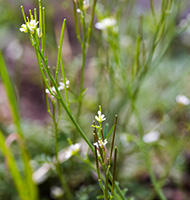Do You Have a Family Cress? – Hairy Bittercress
Do You Have a Family Cress? – Hairy Bittercress
By the Site Ecology Team (SET) and Wildlife and Industry Together (WAIT)
March 29, 2016

You usually hear of Family Cress being associated with European and Western Asian Nobility. Early immigrants to America could often trace their heritage to the old country families. They took pride in displaying their Cress and Coat of Arms.

Photo courtesy of Melissa McMasters
What about today? Even now Cress can be found on most North Carolinians’estates. Yours may not look exactly like what’s found in the history books, but there are other places to look. Check the local library under 580. BOT. Search under Brassicaceae for the Cress that most closely exemplifies your family’s background and personality. You will find such examples as Lamb, Spring, Wood, Flickweed, Hairy, Hoary, Land, Pepperweed, Shotweed, Snapweed, or even BitterCress. Certainly one of these would be suitable.
If the spelling hasn’t given it away, these names should have.
I’m really talking about a well-known winter annual, Hairy bittercress (Cardamine hirsuti) that has populated most gardens and lawns in our area.

Photo courtesy of Melissa McMasters
We see and feel it but don’t know what it is. Spring finds the flat winter rosette sending up multiple shoots with small white flowers. These soon change into long cylinder seed capsules (March-May). The seed pods are dehiscent and will explode out their seeds with the slightest touch. It’s estimated that one plant can produce over five thousand seed. Seed have no dormancy requirement and can germinate quickly.
Once Bittercress is established in a lawn, it’s difficult to eradicate. These plants are food for spring azure (Celatrina ladon) and falcate orange-tip (Anthocharis midea) caterpillars. As a member of the mustard family, it is edible for humans, so if you hurry, you can gobble it up before the insects do. Bittercress hosts aphids, whiteflies and mites, so, it’s best to control its spread by consumption and not allowing it to go to seed.



